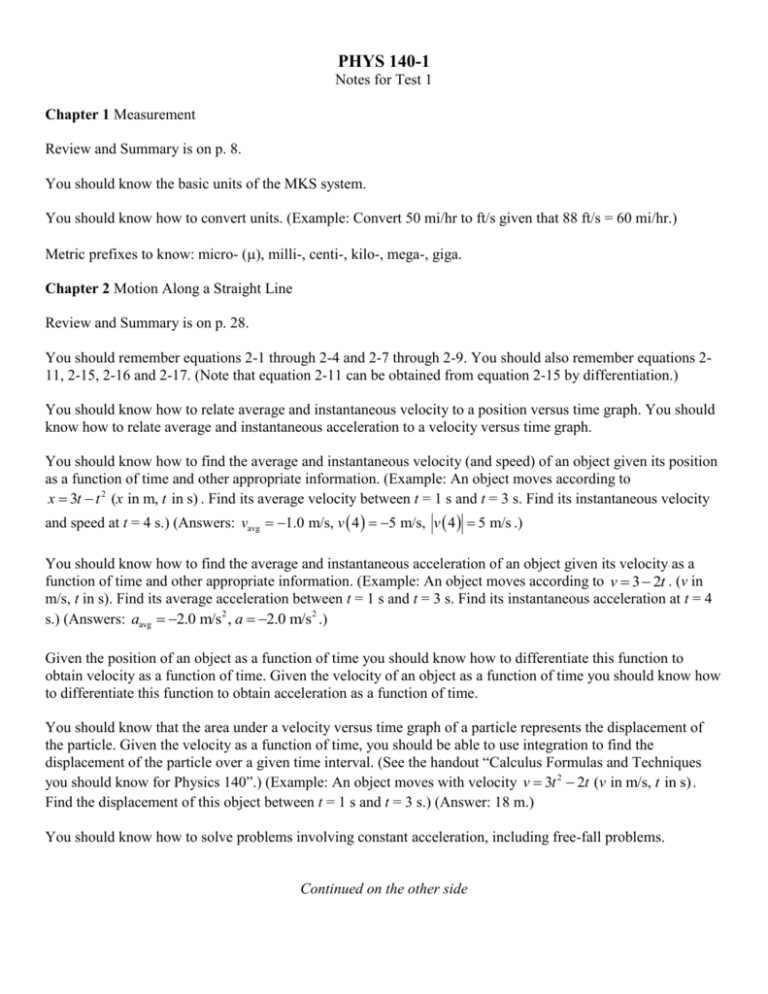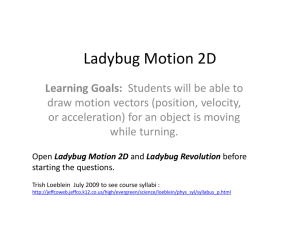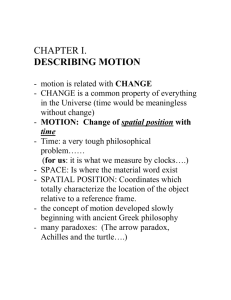PHYS 140-4
advertisement

PHYS 140-1 Notes for Test 1 Chapter 1 Measurement Review and Summary is on p. 8. You should know the basic units of the MKS system. You should know how to convert units. (Example: Convert 50 mi/hr to ft/s given that 88 ft/s = 60 mi/hr.) Metric prefixes to know: micro- (), milli-, centi-, kilo-, mega-, giga. Chapter 2 Motion Along a Straight Line Review and Summary is on p. 28. You should remember equations 2-1 through 2-4 and 2-7 through 2-9. You should also remember equations 211, 2-15, 2-16 and 2-17. (Note that equation 2-11 can be obtained from equation 2-15 by differentiation.) You should know how to relate average and instantaneous velocity to a position versus time graph. You should know how to relate average and instantaneous acceleration to a velocity versus time graph. You should know how to find the average and instantaneous velocity (and speed) of an object given its position as a function of time and other appropriate information. (Example: An object moves according to x 3t t 2 (x in m, t in s) . Find its average velocity between t = 1 s and t = 3 s. Find its instantaneous velocity and speed at t = 4 s.) (Answers: vavg 1.0 m/s, v 4 5 m/s, v 4 5 m/s .) You should know how to find the average and instantaneous acceleration of an object given its velocity as a function of time and other appropriate information. (Example: An object moves according to v 3 2t . (v in m/s, t in s). Find its average acceleration between t = 1 s and t = 3 s. Find its instantaneous acceleration at t = 4 s.) (Answers: aavg 2.0 m/s2 , a 2.0 m/s2 .) Given the position of an object as a function of time you should know how to differentiate this function to obtain velocity as a function of time. Given the velocity of an object as a function of time you should know how to differentiate this function to obtain acceleration as a function of time. You should know that the area under a velocity versus time graph of a particle represents the displacement of the particle. Given the velocity as a function of time, you should be able to use integration to find the displacement of the particle over a given time interval. (See the handout “Calculus Formulas and Techniques you should know for Physics 140”.) (Example: An object moves with velocity v 3t 2 2t (v in m/s, t in s) . Find the displacement of this object between t = 1 s and t = 3 s.) (Answer: 18 m.) You should know how to solve problems involving constant acceleration, including free-fall problems. Continued on the other side Chapter 3 Vectors Review and Summary is on p. 52. You should remember equations 3-5, 3-6, 3-7, and 3-10 to 3-12. You should know how to add and subtract vectors using the head-to-tail method, the parallelogram method and the method of components. You should know the meaning of the unit vectors i, j and k and how to express a vector in terms of the unit vectors. You should know how to find the scalar product of two vectors and equations 3-20 and 3-23. You should know how to use the scalar product to find the angle between two vectors. You should know how to find the vector (or cross) product of two vectors and equation 3-27.









